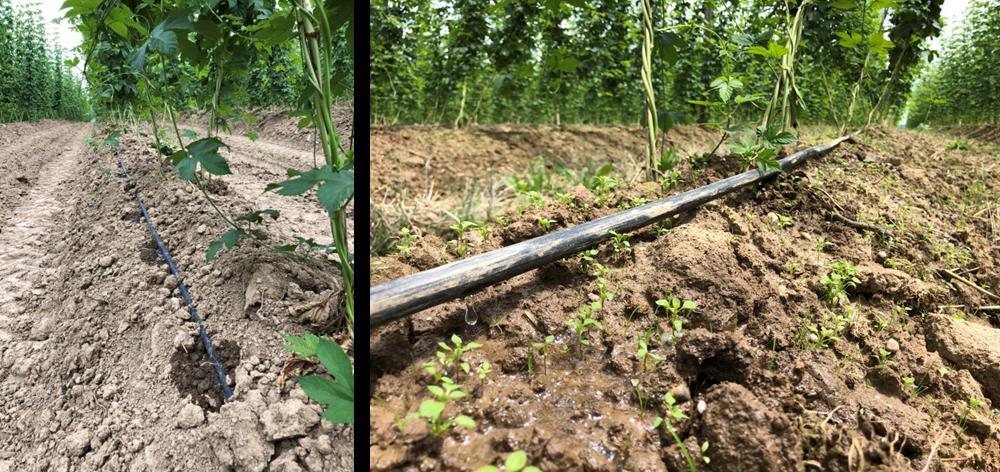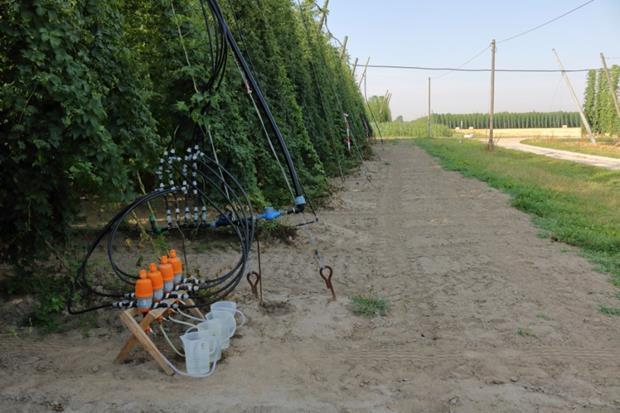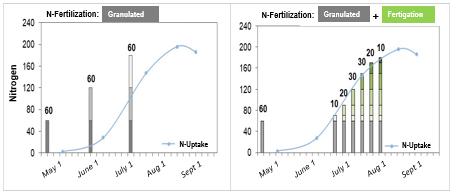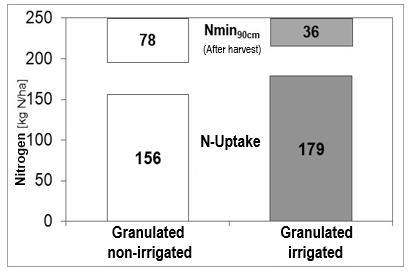
8 minute read
systems with fertigation (ID 5612
4.2 Improvements in the nutrient efficiency of hops through fertilization systems with fertigation (ID 5612)
Sponsor: Bayerische Landesanstalt für Landwirtschaft, Institut für Pflanzenbau und Pflanzenzüchtung, AG Hopfenbau, Produktionstechnik (IPZ 5a) [Bavarian State Research Center for Agriculture, Institute for Plant Production and Plant Breeding, AG Hop Production, Production Technology (IPZ 5a)] Financing: Erzeugergemeinschaft HVG e. G. (HVG Hop Producer Group) Project Management: J. Portner Team: J. Stampfl, S. Fuß Collaboration: Prof. Dr. T. Ebertseder, Hochschule Weihenstephan-Triesdorf (Weihenstephan-Triesdorf University of Applied Sciences) Prof. Dr. F. Wiesler, LUFA Speyer Hop farms in the Hallertau Duration: March 2017 to December 2020
Hop plants place high demands on the water supply in order to deliver stable yields at a high quality. If the cultivation takes place in areas with a humid climate, both the absolute amount of precipitation and the distribution of precipitation over time are important. However, the global climate change is already causing a measurable rise in temperatures, as well as an increase in the frequency of extreme weather conditions such as dry periods and periods of heavy precipitation. The effects of these worldwide developments have become more pronounced in the German hop-growing regions in recent years. As a result of the deteriorating water supply, the production of hops in sufficient quantity and at high quality is becoming increasingly difficult, which means that it is also becoming more complicated to plan outcomes in the entire hop value chain. In addition to breeding new hop varieties with a higher tolerance for heat spells and dry periods as an adaptation to the consequences of climate change, additional irrigation with water-saving drip irrigation systems is also a possible adaptation strategy.
Figure 4.2: Drip irrigation systems for hops
In principle, irrigation systems not only ensure that the plants receive an adequate supply of water but also open up the opportunity for delivering plant nutrients in a targeted manner together with the water. This form of fertilization, known as fertigation, is highly efficient. It is already used in many agricultural segments, especially in regions of the world with arid and semi-arid climates and thus high irrigation requirements. Thus far, in hop cultivation, fertigation has been used mainly in the Yakima Valley in the USA. There, the required plant nutrients are delivered dissolved in irrigation water. In German hop cultivation, on the other hand, the plants’ nutrient requirements are met primarily through the application of granulated fertilizers. Unfortunately, the plants’ availability to take up scattered, granulated nutrients is severely limited, especially under dry conditions. The most important and most yield-limiting nutrient in hops, as is the case for many other crops, is nitrogen (N). However, because of the potentially large environmental impact of nitrogen, German laws and regulations are increasingly limiting the maximum amount of nitrogen fertilizers that can be used for hops. This means that new fertilization methods, including the targeted and needs-based application of nitrogen via irrigation water (fertigation), could become an option in Germany to achieve a more efficient use of the quantities of nitrogen that are still permitted. This means that both additional irrigation and fertigation represent potential solutions for combatting climate change and securing hop cultivation in Germany long term. The Bavarian State Research Center for Agriculture has been investigating the effects of irrigation and fertigation since 2017, as part of a research project funded by the HVG producers' association.
Nitrogen fertilization systems with fertigation
Initially, this research focused on the development of nitrogen fertilization systems with fertigation. The aim was to achieve a more precise dosage of N-fertilizations relative to the plant’s N-uptake, as well as its soil-derived N-replenishment. Various field tests conducted in the Hallertau since 2017 served as the conceptual basis for the study. In these tests, the effects of different N-addition, varied in terms of timing and amounts, were analyzed.

Figure 4.3: Fertilizer dispensing device for fertigation One essential finding was that the plant absorbs nitrogen immediately if it is applied via irrigation water and that this allows for short-term interventions in the plant’s nitrogen balance.
In contrast to nitrogen fertigation, the availability of nitrogen supplied to plants exclusively in the form of granulated N-fertilizer is strongly dependent on the vagaries of precipitation. Both dry spells and periods of heavy precipitation can, therefore, interfere with the plants’ nitrogen uptake. Fig 4.4 juxtaposes the data for an N-fertigation system with one that relies exclusively on granulated N-fertilizer. For this, starting in calendar week 25, the plants received two-thirds of the total nitrogen additions, spread over six individual applications over a six-week period, during the plants’ main biomass formation. The remaining one-third of the nitrogen was applied in granular form. The amount of N that can be applied in practice via fertigation depends primarily in whether a farm applies organic fertilizers as well and whether nitrogen-containing nutrient solutions are used during hop culling.

Figure 4.4: Comparison between a fertilization system exclusively with granulated Nfertilizer (left) and a combination system with two-thirds N-fertigation and one-third granulated N-fertilizer (right).
Effects on yield and quality
In addition, the three-year study investigated the effects on yield and quality from additional above-ground drip irrigation in conjunction with fertigation. This was a static field test planted with Perle on sandy soil. The study lasted from 2017 to 2019 (Figure 4.5). It showed that additional irrigation in conjunction with an N-fertilization level of 150 to 180 kg/ha of N, distributed in granulated form over 3 applications, increased the yield over three years by an average of 7% and that of the alpha acid content by 15%. However, if one-third of the total N-fertilization was in granulated form and two-thirds via fertigation, the yield increased by an average of 15% and the alpha acid content by 23%. The differences between the processes are especially noticeable when comparing alpha amounts. In addition to these averages, the effects are of decisive importance for growing hops in dry years. In the 2017 crop year, there was a severe drought from mid-June to the end of July while the cones were developing. For this year, the yield and alpha acid increases amounted to 12 and 17%, respectively, for just irrigation, and to 20 and 27%, respectively, if fertigation was added. The positive effects of N-fertilization systems that include fertigation compared to those that rely exclusively on spreading N-fertilizers were confirmed in all field tests. Thus, it is clear that an effective stabilization of the yield and of the quality of hop cropsis possible through a combination of irrigation and fertigation. Combination irrigation systems are plainly more efficient.

Figure 4.5: Perle variety - sandy location - 3-year test mean values (2017 to 2019); Cone yield, alpha acid content and alpha yield. Statistical evaluation: values with the same letters do not differ significantly from one another.
During irrigation and fertilization tests in plots with Herkules, it was also found that high levels of N-supplies, starting in early August when the plant synthesizes alpha acids, can lead to significant reductions in both alpha acid content and alpha yield. The reasons for high Nsupplies can be late or excessive N-fertilization, as well as a high amount of mineral nitrogen in the soil (Nmin) or a high N-replenishment. For plots where nitrogen was applied in granulated form only, periods of drought led to a delayed nitrogen effect, meaning that there was an increased carry-over risk of too much nitrogen available as the plant was synthesizing alpha acids. By means of targeted N-applications via fertigation, on the other hand, needbased nitrogen nutrition became a possibility and a reduction of the alpha acid content was effectively avoided.
Effects on nitrogen utilization and nitrogen efficiency
The effects of irrigation and fertigation on the plants’ nitrogen use will continue to be studied with the goal of determining the most efficient uptake by the plants of nitrogen supplies. It has already been shown that above-ground irrigation, in conjunction with a combination system of N-fertilization at constant total levels of nitrogen, results in an increase in nitrogen uptake by the plants through improved biomass formation (Figure 4.6). At the same time, the soils had lower residual Nmin levels in the fall after the harvest. Therefore, additional irrigation during dry periods leads to a diminished risk of nitrates leaching into groundwater.

Figure 4.6: Perle variety - sandy location - trial year 2017: Nitrogen uptake by the plants and Nmin content in the soil in the fall after harvest.
The study also determined that in different test years at different locations, the application of a proportion of the total amount of N-fertilization via irrigation water leads to a significant increase in the effectiveness of N-fertilization, especially under conditions of limited Nsupplies. For example, the effects of N-fertilization on Perle planted at a loamy location in crop year 2018 is shown in the table below. N-fertilization systems with fertigation produced both an increase in the percentage of N-utilization (as a percentage of the total amount of applied N) and an improvement in the yield per kilogram relative to the amount of nitrogen used (agronomic N-efficiency).
Table 4.2: Perle variety - loamy location - trial year 2018: Comparison between the effects of granulated N-fertilization and fertigation on agronomically and ecologically relevant factors.
Yield N-Depletion N-Utilization Agro. N-Efficiency
[kg/ha] [kg N/ha] [%] [kg Cones/kg N]
Granulated irrigated 2.242 135 30 Fertigation 2.719 177 72 4,6 9,4
Conclusion
To sum up, it is a fair conclusion that irrigation and especially N-fertilization systems with fertigation represent an effective solution for counteracting the effects of climate change in German hop growing in the future. Agronomic parameters, such as the yield and alpha acid content, can be stabilized. In addition, such ecologically relevant indicators as the N-balance can be improved, thereby reducing the risk of nitrate leaching into groundwater. More detailed information about the subject can be found in a set of LfL brochures entitled “Drip irrigation and fertigation in hops.” A summary will also be published online in an ALB information leaflet, which was not yet completed at the time this annual report went to press. In addition, all research results of the project presented here can found in greater detail in a dissertation by Johannes Stampfl, to be completed in the spring of 2021, entitled “Need-based nitrogen nutrition of hops (Humulus Lupulus L.) through fertilization systems with fertigation.”









